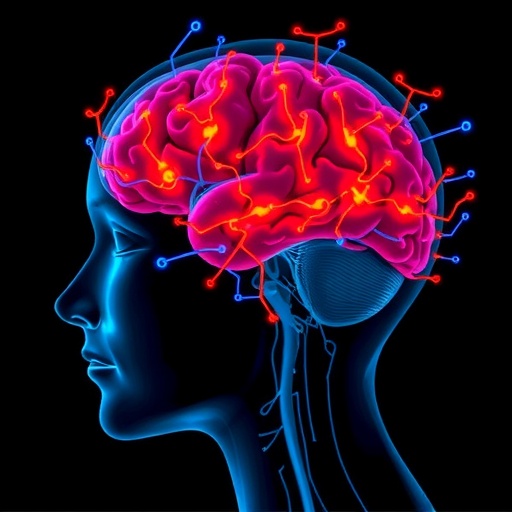In recent years, there has been increasing interest in the classification of psychiatric disorders using advanced computational techniques. One of the most pressing concerns in the field of mental health is the effective identification and treatment of Schizophrenia Spectrum Disorder (SSD). Early diagnosis is vital for improving patient outcomes and enhancing intervention strategies. A recent study published in BMC Psychiatry sheds light on the potential of machine learning and functional connectivity metrics as diagnostic tools.
The investigation conducted by a team of researchers aimed to delve into whether brain metrics derived from patients with chronic, medicated SSD could serve as reliable biomarkers for the early identification of this complex disorder. Traditional classifications have often centered on established SSD populations, neglecting the nuances presented by individuals experiencing early-stage symptoms. This study uniquely positions itself within this context, aiming to bridge the gap between chronic and nascent forms of SSD by examining functional connectivity features.
A comprehensive dataset was employed for this research, consisting of 502 SSD patients from varied clinical backgrounds and 575 healthy control participants. The study was notably structured across four distinct medical institutions, facilitating a more diverse and balanced dataset that bolstered the study’s findings. Employing resting-state functional connectivity (FC) data, the researchers trained a Support Vector Machine (SVM) classifier specifically designed to distinguish between chronic, medicated SSD patients and healthy controls from three of the participating sites.
An essential component of this research was the independent validation of the developed classifier. The fourth site provided a robust testing ground, comprising both chronic medicated SSD patients and first-episode, unmedicated individuals. This methodological approach illuminated whether the features recognized in chronic patients were applicable to those in the early stages of the disorder, emphasizing an essential question in psychiatry: can chronic conditions inform early diagnostics effectively?
The results of the study revealed significant insights into the classifier’s performance metrics, achieving an accuracy rate of 69%. Notable statistics included a 63% sensitivity and 75% specificity, factors that illuminate the algorithm’s effectiveness in distinguishing between SSD patients and healthy individuals. Furthermore, the area under the receiver operating characteristic curve was recorded at 0.75, underscoring a promising level of diagnostic capability. The F1-score and positive predictive rate offered additional validation, reaching 69% and 72% respectively.
However, not all groups responded equally to the classifier’s predictions. The subgroup analysis indicated a sensitivity rate of 71% specifically for chronic medicated SSD patients. In stark contrast, the classifier displayed a much lower sensitivity of 48% when applied to first-episode unmedicated patients—a statistic that raises questions surrounding the applicability of models developed from chronic cases. The study also performed a univariable analysis, revealing a significant correlation between functional connectivity and medication usage, suggesting that current models might be capturing state features rather than true traits of SSD.
The study’s authors emphasize that while their findings illuminate a path forward, they also highlight significant limitations in the current approaches to classifying schizophrenia. The classifiers, they argue, appear to predominantly reflect the impact of medication and chronicity, which may obscure essential core traits of the disorder itself. This revelation calls into question the efficacy of existing diagnostic frameworks as they relate to diverse patient populations struggling with SSD.
Moreover, the implications of this research extend beyond mere classification. There is a pressing need for the development of more nuanced models that can detect the early neural pathology associated with schizophrenia. By refining our understanding of how SSD manifests in its nascent stages, mental health professionals can provide timely interventions, ultimately leading to improved patient outcomes.
As the field moves forward, there is an immediate need to incorporate models that prioritize the characteristics of early-stage SSD rather than relying heavily on data derived from chronic patients. This calls for a community-wide reconsideration of how SSD is approached clinically, emphasizing the integration of innovative methodologies that can dynamically evolve with our understanding of the disorder.
The findings of this study encourage a paradigm shift in the how we think about diagnosing and classifying SSD. With the potential of machine-learning classifiers to enhance early identification, researchers are now confronted with the vital task of developing more versatile models that can effectively cater to varying clinical states.
As researchers continue to explore and expand upon these findings, it remains imperative that the mental health community critically evaluates existing practices and standards to improve care for those affected by schizophrenia spectrum disorders. In an evolving landscape of mental health research, the intersection of technology and traditional methodologies may hold the key to unraveling the complexities of psychiatric disorders such as schizophrenia.
As the study takes a significant leap forward in this regard, one can only hope that the dreams of early detection and enhanced treatment become a reality for the many individuals impacted by SSD. Ultimately, this journey reflects not just an exploration of technology and neuroscience but a genuine pursuit of compassion and healing within the field of psychiatric care.
Subject of Research: Schizophrenia Spectrum Disorder classification using machine learning and functional connectivity.
Article Title: Classification of schizophrenia spectrum disorder using machine learning and functional connectivity: reconsidering the clinical application.
Article References: Li, C., Chen, J., Dong, M. et al. Classification of schizophrenia spectrum disorder using machine learning and functional connectivity: reconsidering the clinical application. BMC Psychiatry 25, 372 (2025). https://doi.org/10.1186/s12888-025-06817-0
Image Credits: Scienmag.com
DOI: https://doi.org/10.1186/s12888-025-06817-0
Keywords: Schizophrenia, Machine Learning, Functional Connectivity, Early Detection, Psychiatric Disorders.




